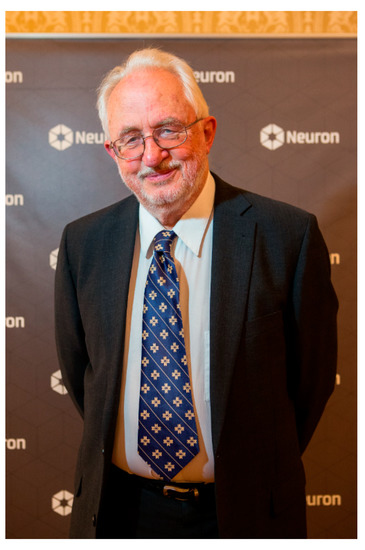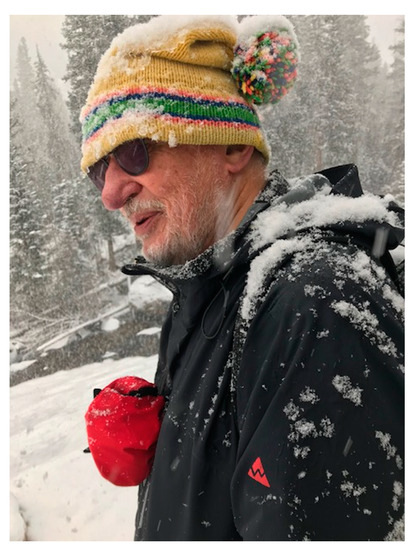It is our great pleasure to introduce the Festschrift of Chemistry to honor professor Josef Michl (Figure 1) on the occasion of his 80th birthday and to recognize his exceptional contributions to the fields of organic photochemistry, quantum chemistry, biradicals and biradicaloids, electronic and vibrational spectroscopy, magnetic circular dichroism, silicon and boron chemistry, supramolecular chemistry, singlet fission, and molecular machines.

Figure 1.
Josef Michl, credit from Neuron Foundation.
Josef Michl was born in Prague, Czechoslovakia, in 1939, just at the beginning of World War II. Hard times for the family continued even after the war when the Communists seized power in 1948. Despite all that, Josef received an excellent education. He warmheartedly remembers his elementary- and high-school teachers whom he credits for his love of chemistry, as well as his very tolerant parents who allowed him to perform his first chemical experiments in the kitchen. He studied chemistry at Charles University in Prague and received the M.S. degree in 1961 with physical organic chemist Václav Horák and electrochemist Petr Zuman. He chose Rudolf Zahradník, an outstanding physical chemist, as his Ph.D. project supervisor to work simultaneously on the theory, electronic spectroscopy, and synthesis of non-alternant π-electron systems. He was introduced to photophysics during his postdoctoral studies with Ralph Becker at the University of Houston and Andy Albrecht at Cornell and to 19F NMR spectroscopy in the laboratory of Michael Dewar at the University of Texas, Austin. His short return to Prague was interrupted by the Warsaw Pact invasion of Czechoslovakia in 1968. At the time of this attack, while participating in the Löwdin summer school of quantum chemistry in Norway, he decided to join a theoretical physicist Jan Linderberg in Aarhus, Denmark. In 1969, Josef married the love of his life, Sara, a political scientist. They loved traveling around the world, especially mountain climbing (Figure 2), and Josef enjoys telling of their adventures, such as crossing the Andes as they walked from Argentina to Chile or climbing Mt. Kilimanjaro, Tanzania, when Sara was pregnant with their first child. Life inflicted severe wounds on Josef when two of their three children succumbed to cancer, and more recently, when Sara passed away after half a century of blissful companionship.

Figure 2.
Josef Michl, credit from Veronica Vaida.
After the stay in Aarhus, Josef accepted a postdoctoral position with Frank Harris at the University of Utah to learn ab initio calculations and, in 1970, a research faculty position at the same institution. At this time, he joined the community of organic photochemists and started a long-term cooperation with many prominent physical and organic chemists. Josef quickly attained the rank of full professor and later served as chairman of the Department of Chemistry. Then, he moved to the University of Texas at Austin as the M. K. Collie-Welch Regents Chair in Chemistry (1986) and finally to the University of Colorado, Boulder (1991), where he still works and teaches. When Czechoslovakia became a democratic country again in 1989, Josef was free to travel back to his homeland, and since 2006, he has held the position of head of the research team at the Institute of Organic Chemistry and Biochemistry, Academy of Sciences of the Czech Republic, Prague. He likes to say that he is delocalized between Boulder and Prague.
Josef has made a significant impact in many fields of chemistry. His independent career at Utah started with the analysis of electronic states of fundamentally important π-systems. This work revealed to the world some of Josef’s classic “pen and pencil” analysis of intriguing puzzles which now can be found in textbooks, such as how two hydrocarbons with identical ionization potentials and electron affinities can have dramatically different colors. If pen and pencil were insufficient, Josef applied advanced spectroscopic techniques and did it with remarkable insight and proficiency.
This work was a stepping stone for the next large research area—organic photochemistry. Josef was one of the most important early contributors to the development of this field as he introduced the notion of excited-state potential energy surfaces that explained the role of “funnels” (or “conical intersections”) as a way for the excited molecules to escape to the ground state. Perhaps it can be said that Josef’s unique advantage of spending a large part of his life traversing mountainous landscapes guided him in defining his famous models for organic photochemistry and showing how correlation diagrams can be used to deduce qualitative shapes of such surfaces. This work introduced important paradigms that have shaped the field, connected photochemistry with photophysics, and led to the famous book that he co-authored with Martin Klessinger. It is widely considered to be a masterpiece.
Josef has applied his knowledge of photochemistry and spectroscopy to the preparation and characterization of many reactive intermediates. This work afforded the first glimpses of the structure of many unusual species, including a highly reactive non-alternant hydrocarbon pleiadene (a molecule with rich chemistry and unusual photophysics), quinodimethanes, biradicaloids, strongly twisted alkenes (such as adamantene), and pyramidalized alkenes, to name just a few. It also provided important early measurements for the structures of benzyne and cyclobutadiene. In the latter case, the double labeling with 13C allowed the measurement of bond lengths and provided evidence for heavy-atom tunneling. The scope of this work ranged from frozen glasses to cluster ions in mass spectrometers.
A logical connection for a very curious man would be to expand these studies to other elements. In his search for the molecules with a Si=Si double bond (in collaboration with Robert West), Josef and his graduate students prepared many silicon structures that had never been directly observed before, including species with divalent or multiply bonded silicon atom. This pioneering work launched a new chapter in silicon chemistry.
Another important insight in silicon chemistry involved the nature of sigma electron delocalization in oligo- and polysilanes, i.e., the silicon analogs of linear hydrocarbons. The electronic states of these molecules are remarkably complicated and are strongly affected by chain conformation. Josef’s work provided a simple, intuitive and general model that explains the origin of the conformational dependence of σ-electron delocalization in saturated chains of carbon and silicon.
In the mid-1980s, Josef developed rigid molecules (“staffanes”) that can serve as elements of a molecular construction kit. These molecules were used to construct arrays of dipolar molecular rotors and propellers in search of surface ferroelectric behavior.
Another very interesting direction of Josef’s research was his work on carboranes. His lab developed a practical synthesis of the key members of this family and investigated the redox couple consisting of the CB11Me12− anion and the isolable CB11Me12●. These species are highly unusual. For example, despite having an almost naked lithium cation, LiCB11Me12 is highly soluble in benzene and toluene. This anion was surprisingly hard to oxidize. Not satisfied with that Josef and his talented students prepared CsCB11(CF3)12, a species that is even more remarkably resistant to oxidation, resisting also strong acids and bases, and all other conditions (although scratching with a spatula would occasionally bring it to a violent explosion). The salts of HCB11F5(CF3)6− are safer and with the reversible redox potential of more than 4 V above that of ferrocene, the isolable blue radical HCB11F5(CF3)6● is a candidate for the strongest known neutral oxidant.
The latest new chapter in Josef’s research is singlet fission, a process in which a singlet exciton splits into two triplet excitons. Although this process has the potential to improve the efficiency of a solar cell by nearly one-half, very few known materials supported singlet fission before Josef applied his insights and creativity. Josef’s work has greatly improved the understanding of the complexity of singlet fission and outlined the general design ideas of organic chromophores that may lead to practical materials in the future.
It would be challenging to provide a complete list of Josef’s achievements, titles, and awards in this text. To name a few, he is a member of the U.S. National Academy of Sciences, the American Academy of Arts and Sciences, and an honorary member of the Czech Learned Society. He served as the President of the International Academy of Quantum Molecular Science, as the chair of the Photochemistry Commission of the IUPAC, as an editor of Theoretica Chimica Acta, and especially noteworthy being his 31 yearlong service as editor-in-chief of Chemical Reviews. He has been a Sloan, a Guggenheim, a Fulbright, and a University of Colorado Faculty Fellow; he received many awards, such as the Cope Scholar, James Flack Norris ACS, Inter-American Photochemical Society, Wichterle, Hammond, and Neuron Foundation Awards, the Schrödinger and Porter Medals, the J. Heyrovský and Charles University Gold Medals, and the Patria Award from the Czech government. He holds honorary degrees from Georgetown University, the University of Pardubice, and the Masaryk University, Brno. He held close to a hundred visiting professorships and named lectureships, delivered hundreds of invited lectures at various institutions and conferences, has served on many professional and editorial boards, advisory councils, and committees, and has organized several international meetings. He has co-authored five books on photochemistry and polarization spectroscopy, and approximately 700 scientific papers in the fields of organic, inorganic, theoretical, and physical chemistry.
Josef is a polymath, knowledgeable not only in chemistry but also, for example, in history. One of us witnessed an extraordinary situation during a tour of the castle Kokořín in central Bohemia. A professional guide was late, therefore, Josef guided us himself, providing exciting, memorable details.
We know Josef as an exceptionally brilliant chemist, a kind, warm and friendly person on whom one can always rely for a lucid explanation of a difficult concept. This Festschrift is a fitting tribute to the great impact he has had on the development of many branches of chemistry.
The final part of this tribute is sealed with a special coda, a poem written by Kathleen F. (Kay) Edwards and Joel F. Liebman solely for this occasion.
- Ode to Josef Michl
- So many chemists’ contribution is about a nickel
- For their studies on latter day parchment and quill
- By contrast, consider a high denomination dollar bill
- Is what we ascribe to … Josef Michl
- So many chemists are moored, like a dock-bound boat
- Others resemble Johnny and Joannie One-Note
- By playing one chord. A few are diverse, but are fickle
- Very few are multiply productive. Here be … Josef Michl
- So many chemists are bland, and provide a slice of dill
- Others’ food is better approximated by an entire pickle
- Almost no others offer a meal that is as nutritious
- Far more than smorgasbord, elegant, scrumptious,
- For this “essen”, too, here be … Josef Michl
- Born 80 years ago in Prague
- Never content to be a cog
- Or just provide a # for a table (log?)
- He sought to scale the cliff, ignore the chaff. span the clef
- As a postdoc, he left home, where to stay?
- Wandered the globe, Now, U Colorado (Boulder), USA
- We celebrate a chemist of the world … our friend Josef
- Kathleen F. (Kay) Edwards and Joel F. Liebman, Maryland, March 2021
Acknowledgments
We are grateful to Professor Jack Saltiel (FSU) for the helpful comments on this tribute.
Conflicts of Interest
The authors declare no conflict of interest.
Publisher’s Note: MDPI stays neutral with regard to jurisdictional claims in published maps and institutional affiliations. |
© 2021 by the authors. Licensee MDPI, Basel, Switzerland. This article is an open access article distributed under the terms and conditions of the Creative Commons Attribution (CC BY) license (http://creativecommons.org/licenses/by/4.0/).